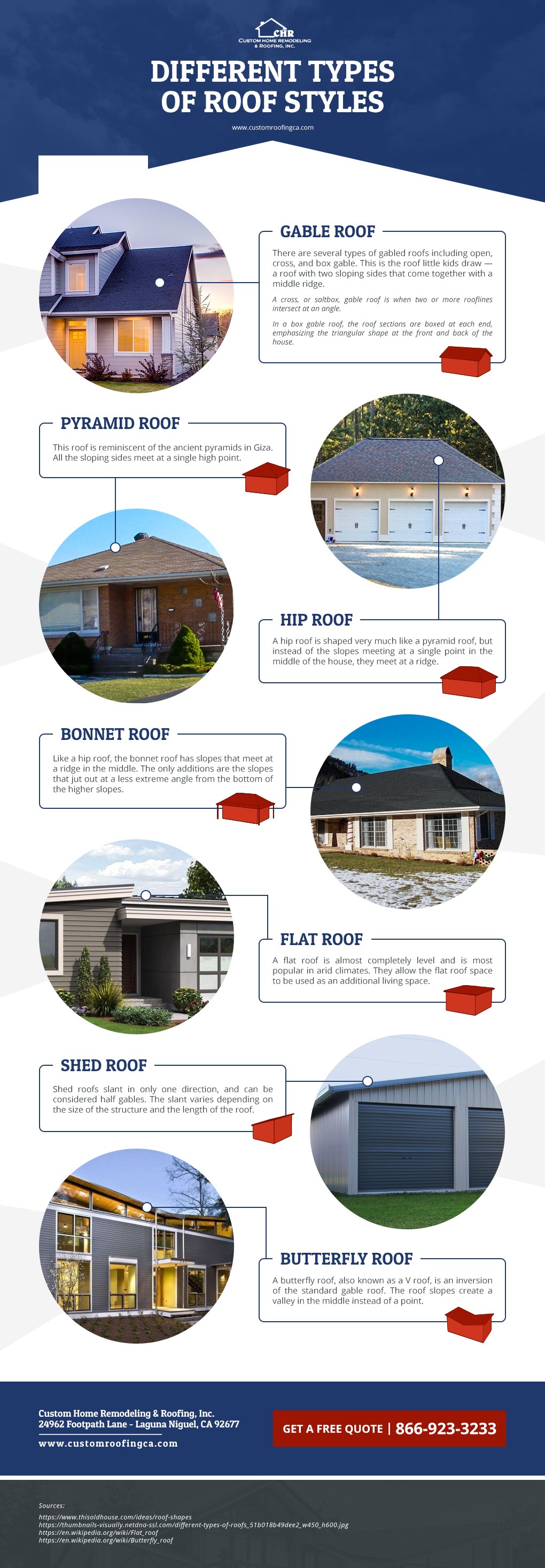
There are many different types of roof styles that are popular throughout America. Modern roofing styles are usually dictated by the environment and weather of your home town, while in older homes, they’re decided by the architecture styles of the time period.
Gable Roof
Gable roofs are the most popular roofs in America. The gable roof is the one little kids draw — a roof with two sloping sides that come together at the middle.There are several types of gabled roofs including open, cross, and box gable.
Cross Gabled Roofs
A cross, or saltbox, gable roof is when two or more rooflines intersect at an angle. You’ll find these in homes that are trying to create more space in the upper portions of the structure. On the interior they look like small reading nooks with windows.
Box Gable Roofs
Box gable roofs, have the same shape as the traditional gable roof, but they also have boxed sections at each end, emphasizing the triangular shape at the front and back of the house. These often have additional windows.
Pros and Cons of Gable Roofs
Gable roofs are the easiest, cheapest style of roof to install. Unfortunately, they’re not very good in areas that have high winds and lots of snow, as they tend to tent and rip off in the wind. If they are built with even the slightest imperfection, they also have trouble supporting a lot of weight, which can be a problem in areas with a lot of snow.
Pyramid Roof
The pyramid roof is reminiscent of the ancient pyramids in Giza. All the sloping sides meet at a single high point in the middle.
Pros and Cons of Pyramid Roofs
Pyramid roofs are a beautiful way to resist high winds and lower your energy bills. Sadly, they are much more expensive to install and maintain due to the large surface areas. This style of roof is also more likely to leak because it does not shed water well.
Hip Roof
A hip roof is shaped very much like a pyramid roof, but instead of the slopes meeting at a single point in the middle of the house, they meet at a ridge.
Pros and Cons of Hip Roofs
Hip roofs are a very stable roof style and they’re great in snowy regions, as the slant of the slopes forces snow to slide right off. They also have a lot more surface area than most other roofs, requiring more maintenance.
Bonnet Roof
Similar to the hip roof style, the bonnet roof has slopes that meet at a ridge in the middle. They have added slopes all around the house that provide more shade for porches in the front and back.
Pros and Cons of Bonnet Roofs
With such a vaulted roof, this type of home has more living space on the interior. The walls also enjoy extra protection from water damage due to the longer slopes that jut out over porches and verandas. Because there are two angles of slopes in this style of roof, water tends to pool where these meet and these areas require additional waterproofing.
Flat Roof
A flat roof is almost completely level and is most popular in arid climates. Fat roof space can often be used as an additional living space with a pool, garden, or deck on top.
Pros and Cons of a Flat Roof
The flat roof is easy to build and relatively affordable. If you have proper drainage, the only other issue you may encounter is debris that collects on the top of the roof.
Shed Roof
Shed roofs slant in only one direction like half of a gable roof. The slant changes depending on the size of the structure and the length of the roof.
Pros and Cons of Shed Roofs
Shed roofs are incredibly easy to assemble and don’t require as much material as other roofs. The steep slope ensure water and snow run off right away, but it is also in danger of catching the wind and tearing off.
Butterfly Roof
A butterfly roof, is an inversion of the standard gable roof. The roof slopes create a valley in the middle instead of a point and is very popular in modern buildings.
Pros and Cons of Butterfly Roofs
With lots of ventilation and natural light, butterfly roofs are very eco friendly. Their only issue is the water damage and drainage problems that may occur without proper waterproofing at the tip of the “V” shape.
Roofing with CHR&R
CHR&R is experienced with many different styles of roofing, including these! If you have questions about what type of roof you have and whether it’s ideal for your environment, reach out to us today!